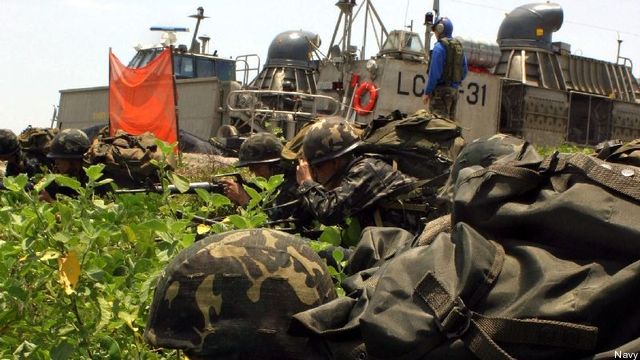Aussies Lead Pacific Pack In Amphib Ops: CSIS
Posted on

Six Pacific partner nations rated for amphibious capability against three scenarios: Humanitarian Assistance/Disaster Relief (HADR); Non-Combatant Evacuation (NEO); Raid against well-armed terrorist group. Japan is not rated for the raid scenario due its constitutional restrictions on military action. (Breaking Defense graphic based on CSIS data)
WASHINGTON: America’s Pacific partners are building up their amphibious forces, but they can’t storm a beach against a high-tech adversary like China. Even the most advanced allies — Australia, Japan, and South Korea — would need US support for a raid against a well-armed terrorist group, especially in command & control, logistics, and helicopters, reports the Center for Strategic & International Studies.
Less developed partners — India and the Philippines — should stick to lower-threat missions, such as Humanitarian Assistance/Disaster Relief (HADR) and Non-Combatant Evacuation Operations (NEOs). Small but sophisticated Singapore falls in the middle of the pack. (We’ve summarized CSIS’s detailed ratings in the chart above).
The bottom line: US strategists must appreciate what each partner can and cannot do and help them to do better at what they’re best at instead of wasting time and money trying to make a mini-me of the Marine Corps.
“They have to be able to do it their way,” said retired Marine Lt. Gen. George Flynn, speaking at the report’s roll-out yesterday. “Their capabilities are going to reflect their national interests. We don’t need to create more of us.”
“Each of those nations brings very capable niche capabilities,” said Lt. Gen. John Wissler, chief of Marine Corps Forces Command. He particularly emphasized mine-sweeping, a chronic US Navy weakness, but critical to any operation close to the coast.

Total tonnage of amphibious warships of six Pacific partners. A single US Navy three-ship Amphibious Ready Group (ARG) totals 90,000 tons; the entire US Navy is over 800,000 tons. (Breaking Defense graphic based on CSIS data)
The Big Three: Australia, Japan, & South Korea
The budding Australian amphibious force comes closest to US capabilities, being a brigade-sized ground force with helicopters and ships to transport it long distances. What inspired Canberra to create this capability was the difficulty deploying and sustaining forces in East Timor in 1999. As it’s evolved, the new force is effectively an Aussie version of a US Marine Expeditionary Unit and its associated Amphibious Ready Group — albeit smaller, with 70,000 tons of shipping versus a US Navy ARG’s 90,000.
By contrast, Japan and South Korea are developing their amphibious forces for short-range operations around their own coastal islands. Korea has a well-armed Marine Corps with tank-like US-made Amphibious Assault Vehicles (AAV) — but it’s so short of shipping that it plans to mobilize car ferries in event of war. Japan, by contrast, has a lot of modern ships suitable for amphibious operations, notably its Hyuga and Izumo-class helicopter carriers — but its nascent army amphibious regiment hasn’t got its AAVs or trained with the Navy amphib ships yet.
That said, both countries are developing rapidly. Korea is building the new Dokdo class of amphibious warships, the largest vessels in its navy. Japan is buying the F-35 Joint Strike Fighter and MV-22 Osprey, and the first Japanese pilot is about to begin MV-22 training, said Lt. Gen. Wissler. Having Japan, and potentially other allies in the future, operate the two mainstays of US Marine Corps aviation will dramatically ease coordinated operations, Wissler said. Australia and Singapore have also expressed interest in the F-35, the report says, while Korea has looked at the V-22.
Regardless of hardware, however, both nations also face political limits. South Korea is unlikely to send sizable forces beyond the peninsula as long as tensions with the North are high. Japan is still so restricted by its pacifist constitution that CSIS did not even rate its forces for the inherently offensive “raid” scenario.

The Limited Partners: India, Singapore, & the Philippines
The other three nations rated — India, Singapore, and the Philippines — face fundamental limits of resources. Singapore is sophisticated and wealthy, but small. In fact, Singapore is so worried about its declining population that it designed its four Endurance-class amphibious ships — Wissler calls them “mini-carriers” — with extensive automation to reduce crew size. (Singapore’s very interested in unmanned and automated systems for the same reason). CSIS rates the Singaporean amphibious force as well-equipped, well-trained, and “extremely capable,” especially in humanitarian operations, but fundamentally limited in what it can do by its small size.
By contrast, India has size going for it, but not much else. Its military is traditionally dominated by the army and the mission of fighting Pakistan. India’s amphibious shipping consists of World War II-style Landing Ship Tank (LST) vessels — giant landing craft that unload by running up on the beach — and a single true seagoing vessel, the ancient USS Austin (renamed Jalashwa). Plans for four new-built amphibious ships remain mired in the usual Indian bureaucracy.
Finally, the Philippines have not one aging US-built ship but a whole creaky fleet of them. Manila is buying a pair of amphib ships from Indonesia, which, while smaller than the smaller US amphib, will still be three times larger than anything else in the Philippine fleet. The country’s Marine Corps is competent at counterinsurgency, CSIS writes, but there isn’t the naval capacity to send them beyond the Philippine archipelago.
No wonder, then, that the Philippines have increased their cooperation with the US, as have Singapore and other partners. The crucial nuance, said CSIS’s Amy Searight, is that no one is offering us bases, but rather access for politically more palatable short-term deployments.
“We have been putting a lot of effort in that area, (and) it’s been clear that we have some relatively open doors,” Searight said. “If we push on some doors, they’re going to open for us.”
Subscribe to our newsletter
Promotions, new products and sales. Directly to your inbox.
